“I date from Little Tupper Lake, and a finer lake it would be hard to find. No desolate lines ofdrowned lands here. All as it came from the hands of nature. Have been out this morning deer hunting, so to speak. Laid off for four mortal hours waiting for a deer to attempt the crossing of Dukett’s Bay. No deer came. But there came a loon, and he settled within ten rods of the canoe, raised himself on hind legs (they are very hind, and he has no others), turned his white, clean breast to me and gave me his best weird, strange song. Clearer than a clarion, sweeter than a flute, load enough to e heard for miles...”
From Nessmuk’s Adirondack letters
Cruise of the Sairy Gamp, 6
Forest and Stream, Sept. 13, 1883
Acquired by the state in 1998-1999, Aim, Caney, and I were among the first legal public paddlers to use Little Tupper Lake and the Whitney Canoe Area in the summer of 1999. It wasn't in a guide book yet, and there was little info, we just happened to drive by the headquarters while going to Lake Lila.
I'd venture to say, over the years, we've logged more nautical miles in the Whitney Canoe Area than anywhere else in the park. Probably in excess of 200 miles. I'd further be willing to bet that every mile on Little Tupper is worth 1.5 miles on any other regularly paddled lake. The wind seems to blow southwest in the morning but in the evening (just in time for the paddle out) it seems to come from the east. I'm guessing this phenomenon is more than just bad luck. Most likely the wind is being generated by adiabatic cooling off the summits of the high peaks after the sun gets low on the horizon.
This weekend we added another 25 miles of paddling to our Whitney Wilderness odometer. In typical fashion we were the first ones in Saturday morning, and the last out after dark Sunday night. Headlamps safely packed in the dry bags we had no choice but to paddle in the dark on a moonless night.
Formerly part of Whitney Park, owned by the Whitney's (of Mary Lou Whitney socialite fame), Gov. Pataki acquired this well logged but fairly pristine tract of land using funds from the Environmental Protection Fund and Clean Water Clean Air Bond Act.
The Whitney's still have a presence in the William C. Whitney Wilderness that is more than the legacy of a name. They own the only two private residences in the wilderness. Camp On The Point, and Camp Francis. They also still own extensive tracts of land forming the southern border of the Whitney Wilderness which comprises the rest of Whitney Park.
In terms of land acquisitions this is about as big as it gets. The Whitney area was logged, lightly mined and has a (unimproved) logging road system, but is essentially pristine in nature.
It supports multiple types of recreation, including skiing, paddling, hiking and horseback riding. As a wilderness, it is motorless, and mountain bikes are also prohibited.
The Whitney Wilderness is so pristine in fact, that Little Tupper Lake is one of the last bodies of water in the northeastern US to retain it's original native trout population. It's an example to me, and hopefully to others, how logged land is far better than paved land with a mini mall on it. Left alone in 20 years only the astute hiker or paddler could tell the difference between land that was logged in a environmentally conscious fashion and native forest. In 50-100 years even they might have a hard time determining just how wild the land was when it was acquired. Those sandy hard packed and shadeless logging roads have a constant tendency to grow in and become the most pleasant grassy woods roads.
All the bodies of water in the WWW are natural and free of man made impoundments. The only dam within the wilderness is located at the Round Lake/Round Lake Stream outlet, and it only serves to raise the water level a maximum of 2-3 feet.
In itself the Whitney Area is an impressive acquisition but when combined with adjoining state lands the magnitude of this purchase really begins to take hold.
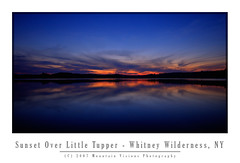 The Whitney Canoe Area adjoins Like Lila Primitive area, and as of 2007 also links to Bog Lake, Clear Pond, and the Oswegatchie via Lake Lila. This essentially opens up multi-day wilderness traverses within this part of the park and makes it far more than the weekend paddlers paradise it has been for many years.
The Whitney Canoe Area adjoins Like Lila Primitive area, and as of 2007 also links to Bog Lake, Clear Pond, and the Oswegatchie via Lake Lila. This essentially opens up multi-day wilderness traverses within this part of the park and makes it far more than the weekend paddlers paradise it has been for many years.
It's now possible to travel for 40-80 miles in several directions with a few short portages. Linking rivers, lakes, ponds and streams, there are numerous options for long distance paddles. And with the exception of the Beaver River, all on Forest Preserve land, or lands with easements.
In 2001 the state began negotiations to purchase the Round Lake Tract from International Paper. Round Lake, a largely a undeveloped wilderness lake, adjoins Little Tupper Lake via a large navigable outlet.
The shoreline of Round Lake was leased from IP to various hunting clubs, but other than some dirt woods roads, and some old razed and largely removed hunting camps it is essentially undeveloped and primitive in nature.
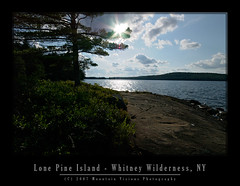 While I'm not entirely sure when it became legal to paddle Round Lake (in 2004 the state still advised against it) this weekend was our first trip to Round Lake. With it's undeveloped irregular shoreline it is a great addition to the Whitney Wilderness. Furthermore, it adds a connection to Tupper Lake and the Bog River from the east via a technical whitewater paddle down the outlet to the Bog River.
While I'm not entirely sure when it became legal to paddle Round Lake (in 2004 the state still advised against it) this weekend was our first trip to Round Lake. With it's undeveloped irregular shoreline it is a great addition to the Whitney Wilderness. Furthermore, it adds a connection to Tupper Lake and the Bog River from the east via a technical whitewater paddle down the outlet to the Bog River.
Round Lake itself is about 1/3 the size of the 6 mile Little Tupper Lake but the shape and irregularity of the lake and the outlet offer quite a bit of paddling. Like Little Tupper, Round Lakes orientation and shape make it prone to wind. The lake is longest in a southwest direction and gets hit with the same winds as Little Tupper.
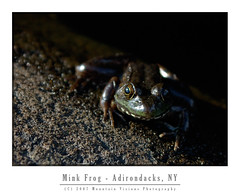 Various frogs, loons, beaver, bats, and fox were all seen on or near Round Lake. There were signs of racoons in a stump at Round Lake Stream outlet which was filled with mussel shells.
Various frogs, loons, beaver, bats, and fox were all seen on or near Round Lake. There were signs of racoons in a stump at Round Lake Stream outlet which was filled with mussel shells.
The state recently finished building primitive campsites on the lake, eleven in total, some of which have yet to be camped on. It appeared sites 1 and 11 were essentially brand new. Quite a treat it is to camp on squishy ground in established campsites, I remember back in 1999 many of the now hardened Little Tupper sites were so similar. Several of the sites were in a odd fashion built on the sites of the former camps. I note this to be odd because the state rarely uses old hunting camps or homesteads as campsites.
In 8 years we have a lot of fond memories of little Tupper, including the first time Caney put his head under the water to get a stick. It might seem trivial but it still amazes us when he essentially snorkels for sticks or frogs. This weekend he decided to fish for fresh water mussels while we slept. We know because he had mussels on up high above the shoreline as we were loading the boat.
Over the years we've explored every cove and outlet on Little Tupper. We've explored Rock Pond and it's outlets. We've hiked into Bum Pond and paddled most the the way to Charlie Pond. We've had a bear in our site once, and just this weekend a fox ran right up to me as I sat by the fire.
Of course some of our strangest memories of Little Tupper have to do with the winds. Little Tupper is a natural wind tunnel, shallow (about 18 feet deep), narrow and long it sucks the prevailing southwest wind up. It doesn't take much for this shallow lake to create white caps and strong winds can be dangerous. We've stood on the shore of our campsite quite a few times watching less fit and less experienced paddlers struggle to find refuge from the wind. Often they are in over loaded boats that ride low to the water line, or trailing a boat with children or enough gear for a month. Waves rocking the boat and wind pushing them into the shoreline, or worse, into the middle of the lake as they battle.
We've watched, and were prepared to go out and rescue, two young girls foolishly paddling around the lake on one of the windiest days I can recall. I sometimes like the battle the wind, paddle through the chop, but that day Aim and I got beat pretty badly and were lucky to be close to our favorite campsite when we called it quits. I was certain for a while those girls were going to swamp or just run out of energy before they made it across. The girls eventually did make it across the 1/2 mile wide section of the lake about 30 minutes later.
Although we've explored quite a bit over the years, we've still yet to link Lake Lila and Little Tupper. We've yet to hike to the summit of Antediluvian Mountain, or complete the paddle to Charlie Pond among many other things. Round Lake and it's outlet, Round Lake Stream, also beg for more exploration with tales of narrow gorges and Class V rapids. Now that the Whitney Wilderness is safely under the protection of Article 14, and part of the Forest Preserve, we can take our time knowing it will be there, as it is today, for generations to come.
William C. Whitney and his family were great stewards to this land, and now the public has the opportunity to enjoy it as well.
technorati tags:ADK, Daks, Adirondacks, Whitney, wilderness, canoe, paddle, paddling, hiking, Round Lake, Eagle Point, Pentax, K10D, Article 14, Forest Preserve, Forever Wild, Little Tupper Lake, Tupper, Rock Pond, Lake Lila, sunset, sunrise, primitive, camping, campsite
Blogged with Flock








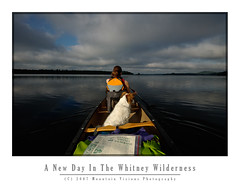
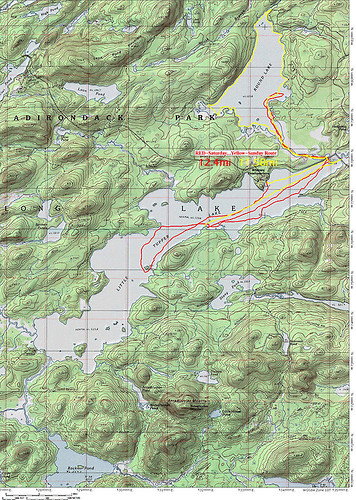
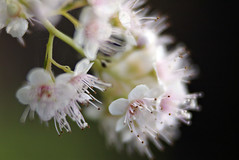
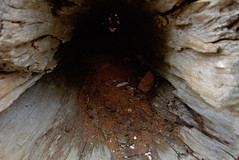
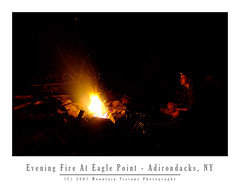
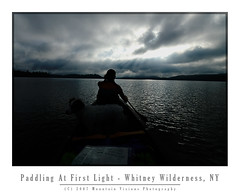



No comments:
Post a Comment